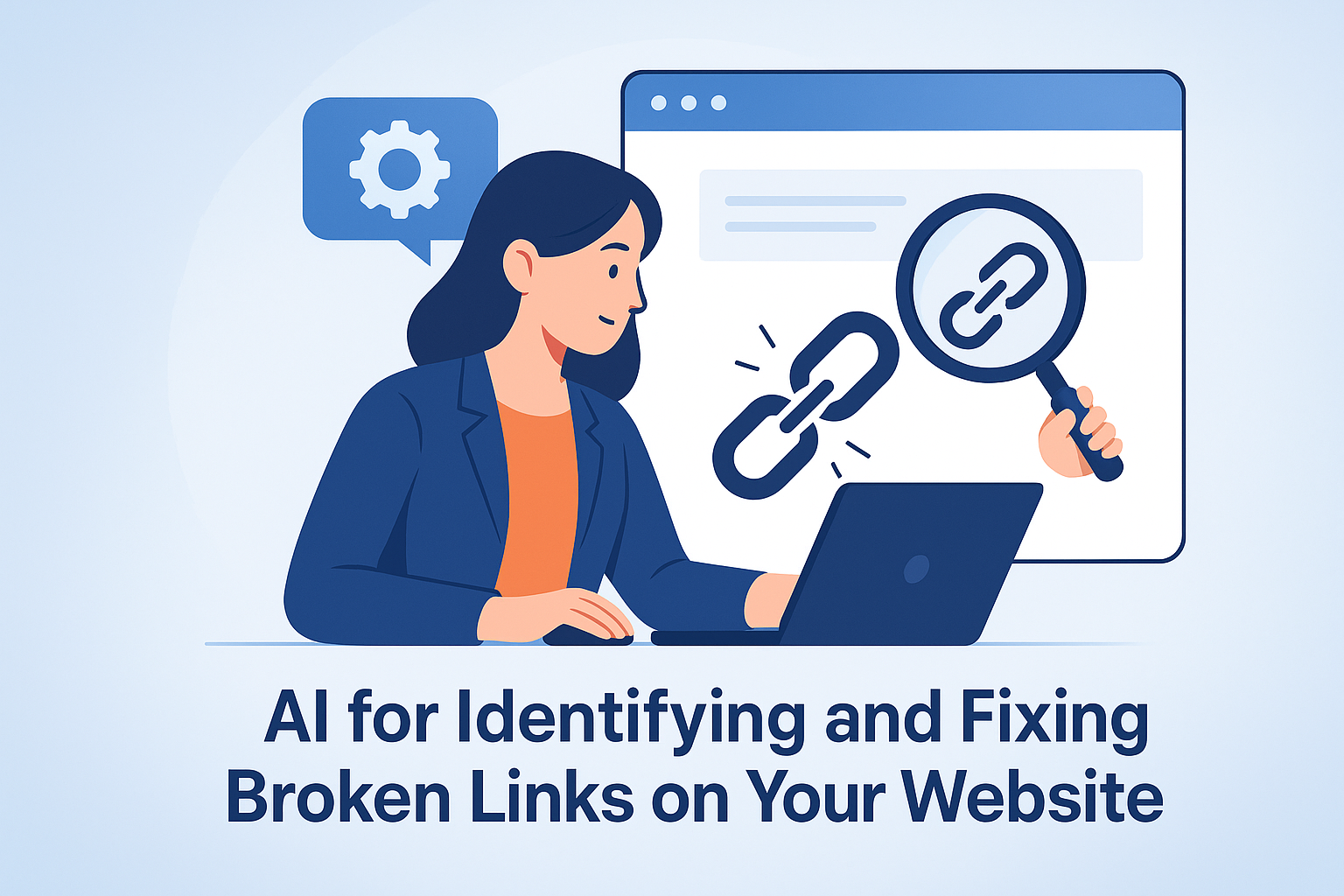Click-through rate (CTR) is one of the most revealing SEO performance metrics—and one of the most underused. A high CTR signals strong alignment between your content and what users want. A low CTR, on the other hand, is often a sign your headlines, metadata, or positioning are missing the mark.
Thanks to artificial intelligence, it’s now easier than ever to analyze CTR data at scale and apply precise, data-driven optimizations. Even better, AI tools like DIYSEO GPT, SEO AI Writer, and the Link Marketplace allow you to take fast action—without spreadsheets, guesswork, or technical bottlenecks.
In this guide, we’ll walk you through how to use AI to:
- Interpret CTR data from your content
- Identify optimization opportunities
- Rewrite titles, meta descriptions, and more
- A/B test updates and track improvements
- Scale high-CTR strategies across your site
Why CTR Matters in SEO
Your organic CTR is the percentage of people who click on your page when it appears in search results.
For example, if 1,000 people see your page and 75 click on it, your CTR is 7.5%.
CTR is not just a surface-level metric:
- It impacts rankings: Google uses CTR as a signal of relevance and quality.
- It affects traffic: Even small CTR improvements can lead to big traffic gains.
- It guides optimization: Low CTR shows you where content isn’t connecting.
That’s why improving CTR is one of the highest ROI activities in SEO.
How to Find CTR Data
The best source for CTR insights is Google Search Console (GSC). In the Performance tab, you can view:
- Queries with impressions, clicks, and CTR
- Pages ranked by average CTR
- Keyword-to-page matching
Export this data to identify underperforming content—pages or keywords with:
- High impressions but low clicks
- Declining CTR month over month
- Top 10 rankings with below-average CTR
Once you know what to improve, you’re ready to bring in AI.
Using AI to Analyze and Optimize Low-CTR Content
Here’s how to use AI-powered tools to interpret, rewrite, and improve content based on CTR performance.
🧠 Step 1: Use DIYSEO GPT to Analyze CTR Patterns
Prompt example:
“Analyze my Google Search Console data. Which pages have the highest impressions but lowest CTR?”
Once you input your data (via copy/paste or uploaded CSV summary), DIYSEO GPT will identify:
- Low-CTR keyword and URL pairs
- Patterns across page types (e.g., blog posts vs. product pages)
- Missed opportunities where a top-ranking keyword isn’t driving clicks
Follow up with:
“What are 3 reasons these pages may have low CTR?”
This gives you cause-based insight: maybe your titles are bland, your meta descriptions are too generic, or you’re competing against rich snippets.
✍️ Step 2: Rewrite Metadata with the SEO AI Writer
Once you’ve identified problem pages, it’s time to improve their search appearance—starting with titles and meta descriptions.
For each page, input the URL and primary keyword into the SEO AI Writer and prompt:
“Generate 3 SEO-optimized title tags and meta descriptions designed to increase CTR for this blog post.”
The AI will vary:
- Emotional pull (“Unlock Your SEO Potential”)
- Curiosity-driven phrases (“You Won’t Believe These Tactics…”)
- Keyword emphasis for relevance
Choose the most promising set or run A/B tests (we’ll cover that below).
🔄 Step 3: A/B Test Different Title & Description Variants
Even a well-optimized title doesn’t guarantee success. Use AI to generate multiple versions, then test them sequentially over a few weeks.
For example:
- Week 1–2: “Best Marketing Tools for 2024 | Your Ultimate List”
- Week 3–4: “Top 10 Marketing Tools in 2024 (With Free Options!)”
Use DIYSEO GPT to run:
“Compare click-through rate for /tools-marketing under each title variation. Which performed better and why?”
Then apply the winning formula to other pages with similar content.
🔗 Step 4: Improve Internal and External Contextual Signals
CTR is influenced not only by your snippet—but also by what surrounds it:
- Internal links: Pages with strong internal linking often appear more relevant in SERPs.
- Backlinks: Higher-authority pages tend to earn more trust and better placement.
- Schema markup: Enabling rich results (FAQ, reviews, events) improves visibility and click-worthiness.
AI can help here too:
Prompt:
“Suggest 3 internal linking opportunities to improve visibility for /how-to-use-keywords.”
Once optimized, you can use the Link Marketplace to build additional external backlinks that give your improved content the trust signals it needs to climb higher in search and earn more clicks.
📊 Step 5: Use AI to Interpret Long-Term CTR Trends
CTR isn’t static. It changes due to:
- SERP layout changes (e.g., ads, featured snippets)
- Competitor moves
- Seasonal search trends
Use DIYSEO GPT for periodic analysis:
“What are the top 3 pages where CTR declined in the past 60 days, and what likely caused it?”
It can surface changes like new competitor content or shifts in user behavior, helping you adapt faster than your competitors.
Elements to Optimize Based on CTR Insights
Here’s what to change when CTR is underwhelming—plus how AI helps.
🔹 Titles
Common fixes:
- Add numbers (e.g., “7 Proven Tips…”)
- Ask a question (e.g., “Why Is Your SEO Failing?”)
- Use power words or urgency (e.g., “Ultimate,” “Now,” “Free”)
With AI: Use the SEO AI Writer to create emotional, keyword-rich titles at scale.
🔹 Meta Descriptions
Common fixes:
- Add a clear value proposition
- Include keywords users are searching
- Add a CTA (“Learn more,” “Get started now”)
With AI: Ask the AI Writer for 2–3 variants focused on different angles (informational, urgency, curiosity).
🔹 URLs and Slugs
Common fixes:
- Shorten long URLs
- Include exact match keywords
With AI: Prompt:
“Recommend SEO-friendly slugs for this blog post: ‘How to Increase Website Conversions in 2024.’”
🔹 SERP Features (Rich Results)
Schema markup helps pages stand out.
Use AI to generate:
- FAQ schema
- How-to schema
- Review markup
- Event schema
Prompt:
“Generate FAQ schema for this post using 3 questions users would ask about [topic].”
Scaling Success: How to Apply CTR Learnings Sitewide
One of the biggest benefits of AI is scalability.
Once you identify a successful formula (like titles that boost CTR 20%+), use DIYSEO to replicate it across other pages:
Prompt:
“Create new SEO title and meta description variants for these 10 URLs using the same style that worked on /blog/seo-checklist.”
Paste your URL list and let AI generate the metadata in minutes—ready for upload or CMS insertion.
AI-Powered CTR Optimization Workflow
Here’s a step-by-step summary you can follow monthly:
| Step | Tool | Action |
|---|---|---|
| Export GSC CTR data | GSC | Filter by low CTR, high impressions |
| Analyze patterns | DIYSEO GPT | Identify causes and content types |
| Rewrite metadata | SEO AI Writer | Create new titles and descriptions |
| A/B test variants | DIYSEO GPT | Monitor CTR shifts weekly |
| Update schema | GPT + Writer | Add FAQ, review, or how-to markup |
| Scale success | GPT | Apply winning structures to more pages |
| Build trust | Link Marketplace | Add backlinks to newly optimized pages |
Final Thoughts
You don’t need to settle for underperforming content. With AI, improving your CTR becomes a repeatable, data-driven process that helps you:
- Attract more organic traffic
- Climb higher in SERPs
- Understand what messaging works
- Outperform competitors faster
With the DIYSEO GPT to analyze, the SEO AI Writer to optimize, and the Link Marketplace to amplify, you have everything you need to make click-worthy content that converts.
Don’t just publish—optimize and scale. With AI, you’re always improving.
Frequently Asked Questions
1. What is an AI-powered strategy for optimizing content based on Click-Through Rates?
AI-powered strategies for optimizing content based on Click-Through Rates involve using advanced algorithms and machine learning models to analyze and predict user behavior. These strategies help businesses tailor their content to better engage audiences and improve CTRs. The AI systems can assess large data sets to identify patterns and trends, suggesting specific changes to headlines, metadata, and visuals that might enhance engagement. For example, an AI tool might analyze the performance of various content pieces and recommend certain keywords, phrases, or even visual elements that are likely to capture attention. By continuously learning from new data, AI helps refine these strategies over time, ensuring that the content remains relevant and appealing to audiences.
2. How can AI tools improve the Click-Through Rates of my content?
AI tools improve Click-Through Rates by offering insights that human analysis simply cannot achieve quickly. They evaluate which factors—be it language style, visuals, posting time, or audience demographics—correlate with higher CTRs. For instance, AI might analyze thousands of email subject lines and identify which ones consistently lead to clicks. It could integrate this with data on audience interactions to suggest creating similar content that resonates with specific demographics. Additionally, machine learning can dynamically adapt content strategies based on real-time performance data, ensuring that each piece of content is optimized for maximum effectiveness. This kind of fine-tuned analysis and rapid adaptation helps maintain a competitive edge in content creation.
3. Are there specific AI tools available for optimizing content for higher Click-Through Rates?
Yes, several AI tools are available that specifically focus on optimizing content for higher Click-Through Rates. Platforms such as Persado use Natural Language Processing (NLP) to craft compelling headlines and advertisements using language proven to increase engagement. Another tool, Crayon, deploys AI to track market trends and ensure content strategies are always ahead of the curve. Additionally, Optimizely offers experimentation capabilities with machine learning to test different content variations to see which performs best. These tools carefully analyze past performance metrics and real-time data to continually refine content, making them invaluable for businesses striving to enhance their CTRs.
4. Can AI-powered strategies help with content distribution and timing to improve CTR?
Absolutely, AI-powered strategies are incredibly effective in optimizing content distribution and timing, two crucial elements for enhancing Click-Through Rates. By analyzing historical data and trends, AI can predict the best times to distribute content to maximize audience engagement. For instance, AI tools can determine optimal posting times on social media or sending times for email campaigns based on when target audiences are most active. Additionally, these strategies can automatically adjust content distribution methods, such as pushing content to users more likely to click, based on AI assessments of user habits and preferences. This precise timing and targeted distribution ensure that content is not only accessible but also engaging when users are most inclined to interact with it.
5. What role does A/B testing play in AI-powered content optimization strategies?
A/B testing plays a crucial role in AI-powered content optimization strategies by allowing businesses to experimentally determine the best performing content variations. AI enhances the traditional A/B testing method by rapidly processing and analyzing datasets to provide insights into why one version might outperform another. AI can run multiple A/B tests simultaneously across different segments and variables, such as content layout, subject lines, images, and calls to action, thus offering a comprehensive understanding of audience preferences. Furthermore, AI’s predictive analysis capabilities can preemptively identify which variations are more likely to succeed before full-scale deployment. This reduces the risk associated with testing and accelerates the process of refining content strategies to maximize Click-Through Rates effectively.



